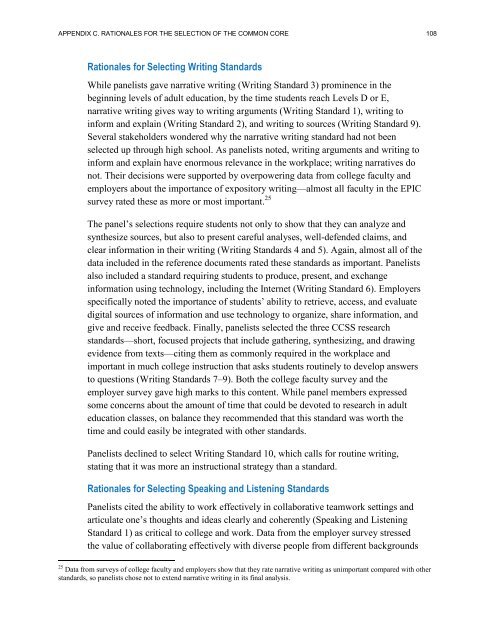CCRStandardsAdultEd
You also want an ePaper? Increase the reach of your titles
YUMPU automatically turns print PDFs into web optimized ePapers that Google loves.
APPENDIX C. RATIONALES FOR THE SELECTION OF THE COMMON CORE 108<br />
Rationales for Selecting Writing Standards<br />
While panelists gave narrative writing (Writing Standard 3) prominence in the<br />
beginning levels of adult education, by the time students reach Levels D or E,<br />
narrative writing gives way to writing arguments (Writing Standard 1), writing to<br />
inform and explain (Writing Standard 2), and writing to sources (Writing Standard 9).<br />
Several stakeholders wondered why the narrative writing standard had not been<br />
selected up through high school. As panelists noted, writing arguments and writing to<br />
inform and explain have enormous relevance in the workplace; writing narratives do<br />
not. Their decisions were supported by overpowering data from college faculty and<br />
employers about the importance of expository writing—almost all faculty in the EPIC<br />
survey rated these as more or most important. 25<br />
The panel’s selections require students not only to show that they can analyze and<br />
synthesize sources, but also to present careful analyses, well-defended claims, and<br />
clear information in their writing (Writing Standards 4 and 5). Again, almost all of the<br />
data included in the reference documents rated these standards as important. Panelists<br />
also included a standard requiring students to produce, present, and exchange<br />
information using technology, including the Internet (Writing Standard 6). Employers<br />
specifically noted the importance of students’ ability to retrieve, access, and evaluate<br />
digital sources of information and use technology to organize, share information, and<br />
give and receive feedback. Finally, panelists selected the three CCSS research<br />
standards—short, focused projects that include gathering, synthesizing, and drawing<br />
evidence from texts—citing them as commonly required in the workplace and<br />
important in much college instruction that asks students routinely to develop answers<br />
to questions (Writing Standards 7–9). Both the college faculty survey and the<br />
employer survey gave high marks to this content. While panel members expressed<br />
some concerns about the amount of time that could be devoted to research in adult<br />
education classes, on balance they recommended that this standard was worth the<br />
time and could easily be integrated with other standards.<br />
Panelists declined to select Writing Standard 10, which calls for routine writing,<br />
stating that it was more an instructional strategy than a standard.<br />
Rationales for Selecting Speaking and Listening Standards<br />
Panelists cited the ability to work effectively in collaborative teamwork settings and<br />
articulate one’s thoughts and ideas clearly and coherently (Speaking and Listening<br />
Standard 1) as critical to college and work. Data from the employer survey stressed<br />
the value of collaborating effectively with diverse people from different backgrounds<br />
25 Data from surveys of college faculty and employers show that they rate narrative writing as unimportant compared with other<br />
standards, so panelists chose not to extend narrative writing in its final analysis.


